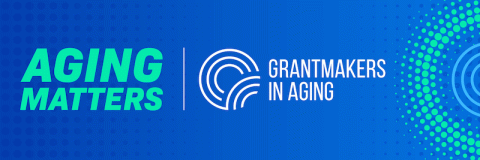
A Message from Lindsay Goldman
Read the full April 2025 edition of Aging Matters
The news has been bleak
Even the pessimists didn’t see this coming. The Administration for Community Living (ACL), a partner to philanthropy since 2012, has been dissolved. ACL’s sole focus was ensuring the health and wellbeing of older people and people with disabilities by working across other government agencies. Many programs that it oversaw are now at risk of elimination or drastic cuts. That includes vital services funded by Medicaid, where massive cuts now seem almost inevitable, (according to the Congressional Budget Office), because the House passed a budget resolution requiring the Energy & Commerce Committee to slash spending by $880 billion.
While doomscrolling on LinkedIn, I saw someone make the point that most Americans – even people who directly benefit from these programs – don’t realize what’s at stake or have any idea that the federal government is involved. Consequently, we’re not hearing widespread opposition.
For example, many beneficiaries of Older Americans Act (OAA) programs do not know that the services they rely on – like Meals on Wheels, elder justice programs, in-home care, senior centers, dementia support, caregiver respite, or adult day programs – depend on major funding from the federal government.
Not enough credit where credit is due
When I ran an OAA-supported adult day program housed in an OAA-supported senior center, every piece of equipment and furniture had to be labeled “Funded in part by the NYC Department for the Aging.” The average observer had no idea that the funding started with the federal government, flowed down to the NY State Office for the Aging, to the city, then to the program. Additional monies (municipal [tax levy] dollars and philanthropic funds) also had to be publicly acknowledged. So the federal government remained a critical but silent and uncredited partner.
Similarly, many people don’t understand the federal government’s huge contribution to Medicaid. This federal-state partnership is funded 31 percent by the states and 69 percent by the feds. (The Commonwealth Fund explains this well.)
People also underestimate Medicaid’s important contributions as we age. One of the biggest is funding “long-term services and supports,” which, contrary to popular belief, Medicare DOES NOT cover.
What’s at stake
Having been “professionally aging” for 20 years, I often forget that most people don’t actually know what “long-term services and supports” are. We need to spell it out, without our typical jargon (ADLs, IADLs and the rest of the alphabet).
For voters, funders, policymakers, and louder for the people in the back: without long-term services and supports – also known as long-term care – you may not be able to:
- Go to the bathroom.
- Move around.
- Get dressed.
- Prepare and eat food.
If you live long enough, you’re likely to need help with some of those essential activities. But even though these needs result from a medical issue, they aren’t considered medical tasks. Without Medicaid, the Older Americans Act, and a skilled direct care workforce, how will you get help?
Aging on the Line
I don’t have the answers. So you’re going to need to “Phone a Friend.” Join us this week for Aging on the Line, a phone and email campaign happening onsite at the On Aging Conference, or virtually from wherever you are (click here). If you are older, or hope to be older in this lifetime, your wellbeing is at stake. Tell your representatives that these proposed cuts are unacceptable. There is too much on the line.